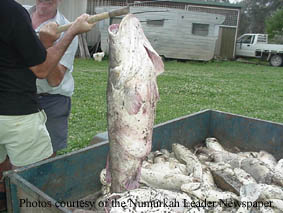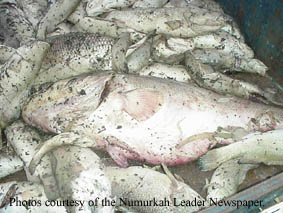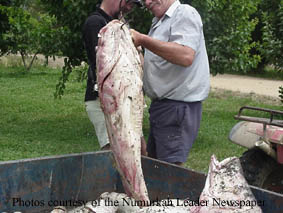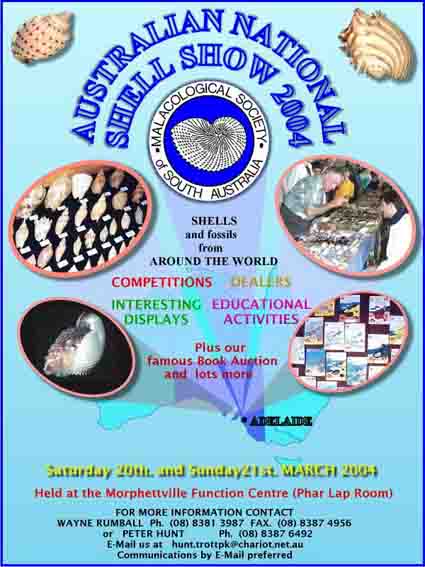MLSSA
Newsletter
NOVEMBER 2003
No. 305
Next Meeting
Our meeting will be held at the Conservation Centre, 120 Wakefield Street, Adelaide on Wednesday November 19th commencing at 7.30pm.
Our speaker will be Robert Browne who will be tackling the topic of "Pipefishes".
Neville Skinner will be showing some slides after the General Business.
Contents
Ewens Ponds
Silver Spots
Worm turns out to be one of man’s closest relatives
Shark Numbers In Decline
South East Marine Atlas
‘Leatheries Vote for More Screwing’
Too Late for the Murray Cod?
Shell Show notice
Contributors
This month our contributors are Steve Reynolds, David Muirhead and Roger Highfield from the UK Telegraph. I really do need more articles for the January 2004 Newsletter!!!!
2003 Journal
As usual there will be no Newsletter published in December. We will be sending out our 2003 Journal to financial members, advertisers and a few other organisations instead.
Ewens Ponds
At our July General Meeting Neville Skinner told us all about a disturbing discovery that he had made whilst snorkelling at Ewens Ponds near Port McDonnell recently. We asked him to put the details into writing so that we could consider what actions were necessary. Robert Browne took up the handling of the information written by Neville. He forwarded the following report from Neville to Philip Hall who on-forwarded it to others:-
"On Sunday 13th July 2003, I snorkelled from Ewens Ponds to the sea with a fellow diver. The creek was absolutely beautiful. Beautiful, that is, until we reached the point where a massive stormwater drain has been directed straight into the creek, about half way down. At the time we were snorkelling down the creek it had been raining. The resultant stormwater that was running from this drain was white from the gravel it was carrying, reducing visibility to about one metre (down from the previous 50-100 metres visibility). At the point where the drain meets the creek the damage is obvious, with the creek bed rising about 30cm from a thick deposit of gravel. Add to this impact the thick layer of dark green algae that was floating on the surface at the drain exit, from the nutrients that are now being discharged into Eight Mile Creek. From then on, all the way to the sea, the complete creek bed, along with the grasses that inhabit the creek, were smothered by this fine gravel. The creek was virtually lifeless frm that point on. I found this both shocking and devastating as up to that point I had not seen such beauty in a creek bed. I appeal to the authorities to take the time to drive down the side road that goes from Ewens Ponds to the sea, alongside that creek. Half-way down there is what appears to be a small bridge, adjacent to some fresh earthworks leading from an irrigation pump (with its 12-15" intake inside Eight Mile Creek) that I assume has been recently installed. (Fortunately, the pump itself does not appear to have caused any impact on the creek.) Stop here and walk to the edge of the creek, which is not fenced off at this point. I am sure you will be shocked at what you see - the problem is most evident from the bank of the creek at this point - the ‘before’ to the right, and the ‘after’ to the left. As I traversed that part of the creek where the water had been fouled from the nutrient-enriched stormwater discharge, it also bothered me to think that this creek must surely be an important life-line for marine life to pass between the Ponds and the sea. This has occurred to one of this states most outstanding natural resources, with Ewens Ponds already having been designated a Conservation Park for some years. Many swimmers and divers travel to Mount Gambier each year to snorkel down Eight Mile Creek from the Ponds to the sea. This must surely beg the question, how can this have been allowed to happen to this creek?"
Neville Skinner
(This letter was first published in full in our September Newsletter. - Ed)
Robert Browne continued to forward updates to MLSSA, including the following report by Daniel Habib:-
"My name is Daniel Habib, and I write to you in regard to the pollution in
Eight Mile Creek, as reported to you by Mr Neville Skinner previously. I
snorkelled the creek with Neville (14/7/03) and have done this many times
before, though this was the first time I had ventured from Ewens Ponds all the
way to the ocean. Like Neville, I was appalled to see such a dramatic change in
the aquatic ecosystem at a single point; a drain. The extent of this damage can
be viewed from the bank of the creek without even entering the water, something
I suggest you do. At the point of the drain, the sub-aquatic terrain changes
from white silt-like sand covered by high-density vegetation, to greyish
‘sludge’ sparsely vegetated, if at all. The change in ecosystem is unmistakably
'black and white'. Furthermore, rubbish is evident down stream of the drain,
particularly at the point of the drain. Such rubbish included batteries,
plastic, bottles, tin cans and other non-biodegradable matter. I'd like to point
out that I did not seea single article of rubbish before the drain. The
visibility of the water also decreases significantly at this point. It appears
that this drain also carries a high sediment load, as the creek is much
shallower down stream of the drain. Evidence of the sediment appears to cover
what little vegetation exists, and in places causes obstacles resembling 'sand
bars'. In short, the creek is reduced from between 1-2 meters pre-drain to less
than 0.5 meter post-drain. Due to the environmental significance of the Ewens
Ponds Conservation Park and associated Eight Mile Creek estuary system, I feel
it necessary to ensure that this matter is investigated further to achieve a
positive outcome for all.
Yours Sincerely,
Daniel Habib"
Using the information first received from Neville Skinner,
I drafted a letter for discussion by our committee. Philip Hall suggested a
couple of changes prior to our meeting. The committee suggested some further
amendments. The result was the mailing of the following letter:-
To:
Department of Environment and Heritage
Minister for Environment & Heritage
Minister for Tourism
Minister for Local Government
Conservation Council of SA
Opposition Environment Minister
"7/8/03
Dear Sir / Madam
We have heard from a reliable source, Mr Neville Skinner, that damage is occurring to the Ewens Ponds system near Port McDonnell. The alleged damage includes sedimentation through a build up of gravel and eutrophication through discharge from adjacent areas.
Mr Skinner claims that "A massive storm water drain has been directed
straight into Eight Mile Creek about half way down. At the point where the drain
meets the creek, the damage is obvious, with the creek bed rising about 30cm
from a thick deposit of gravel. Add to this impact the thick layer of dark green
algae that was floating on the surface at the drain exit, from the nutrients
that are now being discharged into Eight Mile Creek. From then on, all the way
to the sea, the complete creek bed, along with the grasses that inhabit the
creek, was smothered by this fine gravel. The creek was virtually lifeless from
that point on."
Our source goes on to say "Take the time to drive down the
side road that goes from Ewens Ponds to the sea, alongside that creek. Half-way
down there is what appears to be a small bridge, adjacent to some fresh
earthworks leading from an irrigation pump with its 12-15" intake inside Eight
Mile Creek. Stop here and walk to the edge of the creek, which is not fenced off
at this point. I am sure you will be shocked at what you see - the problem is
most evident from the bank of the creek at this point - the ‘before’ to the
right, and the ‘after’ to the left."
The Ewens Ponds system is unique and of international significance in terms of an ecological system. The tourist potential of the system is well known and of economic importance to South Australia and the local economy.
Many swimmers and divers travel to Mount Gambier each year to snorkel down Eight Mile Creek from the Ponds to the sea. This must surely beg the question, how can this have been allowed to happen to this creek?
Eight Mile Creek would probably be an important life-line for marine life to
pass between the Ponds and the sea. This alleged damage has occurred to one of
this State’s most outstanding natural resources.
We believe that the
offending drain should be immediately re-routed thus avoiding further
environmental damage to the Ewens Ponds System.
Could immediate remedial action be taken to restore the Ewens Ponds system to its previous state?
Could someone please explain just how such a structure as the drain could be approved? Has an offence occurred under the EPA Point Source Act? Does the landowner have a Point Source Licence that enables them to do this?
Could some measures now be put in place to avoid further similar damage to these freshwater systems in the future?
Yours faithfully
Steve Reynolds
Secretary
Marine Life Society of SA"
Steve Reynolds
Silver Spots
In my report of my March dive at Second Valley in the August Newsletter I mentioned sighting Silver Spots there. I actually sighted two individuals. These unusual fish, Threpterius maculosus, reach a length of 40cms. I first heard about them when an article by Tony Isaacson was featured in our September 1977 Newsletter (No.14). I then caught one whilst snorkelling at Port Willunga Beach. I wrote about it in our March 1985 Newsletter (No.93). They are found in rocky and weedy areas in shallow waters. They have a prominent silvery spot near their operculum which tends to flicker continuously and may attract small fish to the vicinity of the host’s large mouth. Silver Spots have delicate star-like plumes at the tip of each dorsal spine. These may also attract small fish for the Silver Spot to eat. The Western Coral Fish (Talma), Chelmonops curiosus, have shown interest in the star-like plumes. Silver Spots belong to the family Chironemidae and are related to the Kelpfish. Only the Western Kelpfish, Chironemus georgianus, occurs in SA waters. I don’t know what the date of my snorkel at Port Willunga Beach was since I hadn’t logged it, but just over one year later I caught two Silver Spots at Second Valley. I don’t recall ever seeing any others so it was a pleasant surprise to see two again at Second Valley in 2003. (Note to Chris and David, we don’t have any Silver Spot shots in our Photo Index yet.)
Steve Reynolds
Worm turns out to be one of man's closest relatives
By Roger Highfield, Science Editor
(Filed: 21/08/2003)
©Telegraph Group Ltd 2003 http://www.telegraph.co.uk/
An enigmatic worm that resides in the mud at the bottom of a Swedish fjord is today identified as mankind’s long-lost relative, after being written off for years as an obscure mollusc.
Scientists have discovered one of mankind's closest relatives, among those that lack a backbone, in the shape of a rare 3cm worm called Xenoturbella, they report today in the journal Nature.
The research offers proof that humans and Xenoturbella, whose Latin name means strange flatworm, derive from a common ancestor that lived half a billion years ago, thereby placing Xenoturbella in the same division of the animal kingdom as man and offering new insights into how we evolved.
With funding from the Wellcome Trust, a team led by Dr Max Telford of Cambridge University made the discovery by investigating the genetic make-up of Xenoturbella.
"We have now been able to show that among all of the invertebrates that exist, Xenoturbella is one of our very closest relatives," he said. "It is fascinating to think that whatever long-dead animal this simple worm evolved from, so did we."
His colleague, Dr Sarah Bourlat, was able to purify Xenoturbella's DNA and analysis of this material has shed new light on the origins of this much-neglected species.
"Up until now Xenoturbella had been thought to be related to the bivalve molluscs - which include mussels and oysters," said Dr Telford. "We found this hard to believe as it looks nothing like a bivalve mollusc."
Earlier studies had revealed the genetic make-up of what Xenoturbella had eaten - molluscs - which is akin to classifying a person as a bag of chips, just because that was the last thing they ate.
Shark Numbers In Decline
According to the "Earthbeat" program on Australian Radio National (ABC) on 19th April (repeated 21st April), Peter Benchley has had a change of heart. Peter was the author of "Jaws", the novel that evoked nightmares about sharks. "Earthbeat" said that Peter now wants to protect these feared marine predators and that marine scientists say sharks are in steep decline everywhere. The scientists say that most shark species have dropped by more than 50% in the past 15 years. "Earthbeat" said that only 500 Grey nurse sharks remain off Australia's east coast, making it one of the country's most critically endangered species.
Steve Reynolds
South East Marine Atlas
On 21st March 2002 Senator Ian Macdonald, Federal Minister for Forestry and Conservation, launched the Bureau of Rural Science's publication, "Marine Matters - Atlas of marine activities and coastal communities in Australia's South East Marine Region" at Parliament House, Canberra. This atlas comprehensively maps a range of human activities on, and in, our oceans. It also describes the social conditions in our coastal communities and starts to look at how these towns depend on the marine environment. The Marine Atlas features 93 maps, accompanied by brief comments, covering themes such as total fisheries catch and value, coastal population, employment, oil and gas operations and recreational activities. The atlas is available for loan from our Society library.
Steve Reynolds
Library Officer
In my dreams I imagined this headline to accompany an article in the ‘Adelaide Review’! How on earth, you’ll wonder, did even my convoluted imagination dredge such rubbish out of my subconscious? Well, here’s the ‘article’ in full……!
The corks vs. screwcaps debate may have enlisted an unlikely ally, according to one of the many recreational scuba divers who visit Seacliff Reef.
On 6/1/01 amateur underwater photographer David Muirhead gaped in amazement at a leatherjacket like no other he had ever seen. Despite being the commonist local species this Sixspine Leatherjacket stood out like the proverbial from its jackal-pack mates because it had a cork impaled on its dorsal spine!
Pushed almost down to the hilt, this brownish-yellow wine cork was just starting to mature in its new aquatic environment, with a faint sheen of greenish slime as evidence of its adaptability.
While David photographed this very ‘alternative’ but apparently unstressed leathery, which swam normally and displayed no overtly aberrant behaviour nor buoyancy problems to distinguish it from its 5 or 6 similar-sized companions, he pondered the means whereby a fish acquires a cork.
The likely scenario is that a whiting fisherperson, frustrated by catching wily leatherjackets all day, and perhaps faced with the ultimate insult of hooking the same leathery twice, had surrendered to that most basic instinct, revenge.
Whatever the real explanation for this ugly outcome, it also set David thinking about ‘flow-on’ effects.
The author agrees that diver David was not ‘out of order’ when he said he thought that this experience was another nail in the coffin of cork closures on Australian, and indeed the world’s wine bottles.
So next time you order a bottle of fine fermented Aussie grape juice, I suggest you lean towards the screwcap choice and give corks the flick.
You might be doing a leathery a favour.
David Muirhead
Too Late for the Murray Cod?
The Federal Government has now listed Murray Cod as vulnerable under the EPBC Act (Environment Protection and Biodiversity Conservation Act 1999). The SA State Government has banned commercial fishing in the River Murray. Agriculture, Food and Fisheries Minister, Paul Holloway says that the State Government has always been committed to a policy of removing gill nets from the river. This policy is in line with the Murray-Darling Basin Commission’s Native Fish Management Strategy. The strategy is aimed at restoring fish abundance in the Basin and assisting in the return to a healthy river environment. But is it all too late? Ninety per cent of native fish have already been lost from the Murray-Darling Basin. And late last year the biggest kill of Murray Cod seen in Victoria for decades occurred. On 26th November 2002 rotting Murray Cod started floating to the surface of Broken Creek, north west of Shepparton in Victoria. About 150 Murray Cod were have been buried in a mass grave. Local farmers were using pitch-forks to get the dead fish out of the creek. Some of the dead Murray Cod were over a metre long. The majority of dead cod would have been in the 16 to 25 year old age class. The EPA investigated the kill to find out who was responsible. It has been suggested that bad management caused the tragedy by the authorities. Here are some photos of the dead Murray Cod from Broken Creek. The photos are provided courtesy of Jack Dell from the Numurkah Leader.



The following details were sourced from the Landmark project: -
"As a response to the evidence of environmental degradation in the Murray-Darling Basin, the Landmark project is looking for combinations of dry-land land uses and farming practices that will assist producers to make a good living and create a healthy environment.
The primary objective of Landmark is: "to identify the need for land use and land management change and explore policy responses which may facilitate change in broadacre dry-land regions in the Murray-Darling Basin". This will be done by using sound science to inform good policy.
Landmark is a research and development project funded by the Murray-Darling Basin Commission.
Steve Reynolds
